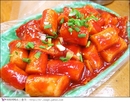글 수 780
| Korean Food: Street Foods (한국의 길거리 음식) [포장마차]street vendor  The pojangmacha (street vendor) is one of the best places to grab a quick snack or pass the night away drinking with friends. The types of food they serve can usually be eaten quickly while standing up (although someplaces have cheap chairs or benches) or take with you. They have many types of food on sticks or "finger foods." Other specialize in seafood and are geared more towards people who want to sit and have some drinks as well. Smaller stands can be easily carried or rolled from place. Larger, more elaborate ones have plastic tarps to protect patrons from the rain and cold. The pojangmacha (street vendor) is one of the best places to grab a quick snack or pass the night away drinking with friends. The types of food they serve can usually be eaten quickly while standing up (although someplaces have cheap chairs or benches) or take with you. They have many types of food on sticks or "finger foods." Other specialize in seafood and are geared more towards people who want to sit and have some drinks as well. Smaller stands can be easily carried or rolled from place. Larger, more elaborate ones have plastic tarps to protect patrons from the rain and cold. [김밥] Rice Wrapped in Seaweed  Gimbap (Rice Wrapped in Seaweed) Gimbap (Rice Wrapped in Seaweed) Gimbap (usually spelled Kimbap) is Korea's most popular and nutritious convenience meal. You can find it sold everywhere: picnics, schoolchildren's lunch boxes, street venders, and convenience stores. A layer of cooked rice is spread over a square piece of gim (dried laver). Various ingredients (including ham, sausage, spinach, cucumber, crab meat, carrots, and radishes) are thinly sliced and placed on top. The laver is rolled into a tube, sliced into sliced pieces, and seasoned with sesame seeds. The idea was borrowed from the Japanese during the colonial period, but Korean Gimbap is slightly different. How to eat: Each roll is sliced into bite-sized pieces. Eat one at a time with chopsticks. If you eat at a street vender, sometimes you have to use a tooth pick instead of chopsticks.
Gimbap is a very popular snack, which can also be eaten as a meal just about anywhere, especially on picnics or outings. It's made by rolling sticky rice in a piece of laver, with strips of crab meat, fish cakes, fried eggs, spinach, carrots, cucumber and radish along the center, then cut into bite sizes. In recent years, new types of gimbap have been introduced with kimchi, tuna, cheese and many other flavors. (김밥은 매우 인기 있는 간식으로 어디서든 식사 대용으로 먹을 수 있으며, 특히 소풍이나 나들이를 갈 때 좋다. 밥을 김에 말아 가운데 게살, 어묵, 계란, 시금치, 당근, 오이, 단무지 등을 넣어 한 입 크기로 썰어 낸다. 최근에는 김치, 참치, 치즈 등의 재료를 넣어 다양하게 맛을 내고 있다.) [만두] Dumplings Mandu (Dumplings)  Circles of wheat dough are pulled around a stuffing mixture of tofu, minced beef, pork, mixed vegetables, or other ingredients. Alternatively, they may be sealed around the filling from the side, forming a crescent shape. Sheredded kimchi, bean sprouts, and small sliced baby squash can be added, depending on the taste. They can be cooked several ways: steamed, simmered in beef stock, or fried. They are served with kimchi on the side and a small container of soy sauce. Use chopsticks to eat, dipping in the soy sauce for taste. (Some places also have crushed red papper to mix with the soy sauce, for an extra spiciness.) Traditionally, the mandu paste was made at home. Nowadays, however, the paste is readily available in supermarkets and convenience stores. Circles of wheat dough are pulled around a stuffing mixture of tofu, minced beef, pork, mixed vegetables, or other ingredients. Alternatively, they may be sealed around the filling from the side, forming a crescent shape. Sheredded kimchi, bean sprouts, and small sliced baby squash can be added, depending on the taste. They can be cooked several ways: steamed, simmered in beef stock, or fried. They are served with kimchi on the side and a small container of soy sauce. Use chopsticks to eat, dipping in the soy sauce for taste. (Some places also have crushed red papper to mix with the soy sauce, for an extra spiciness.) Traditionally, the mandu paste was made at home. Nowadays, however, the paste is readily available in supermarkets and convenience stores. [순대] Korean Sausage Sundae (Korean Sausage)  The small and large intestines of pigs are salted and stuffed with a mixture of pig's blood, rice, green onions, garlic, minced pork, and vermicelli before being steamed. The sausage is sliced when served and some steamed lung and liver slices usually accompany it. It is a very popular dish at street vendors. Use a toothpick or chopsticks to eat, dabbing each piece in salt to taste. The small and large intestines of pigs are salted and stuffed with a mixture of pig's blood, rice, green onions, garlic, minced pork, and vermicelli before being steamed. The sausage is sliced when served and some steamed lung and liver slices usually accompany it. It is a very popular dish at street vendors. Use a toothpick or chopsticks to eat, dabbing each piece in salt to taste. [떡복기]Stir Fried Rice Cake Tteokbokki (Stir Fried Rice Cake)  Long tteok (rice cakes) are stir-fried with carrots, bamboo shoots, mushrooms, and cucumbers and stewed in a gochujang-based sauce. Although it may sound unappetizing, the taste is very good. It is very popular at street vendors. Long tteok (rice cakes) are stir-fried with carrots, bamboo shoots, mushrooms, and cucumbers and stewed in a gochujang-based sauce. Although it may sound unappetizing, the taste is very good. It is very popular at street vendors. from Daum cafe |






 English
English 한국어
한국어

감사함니당